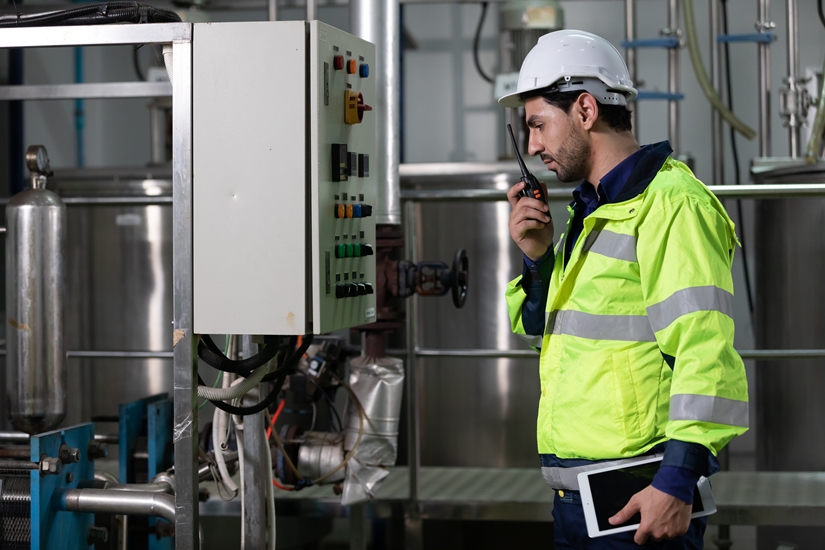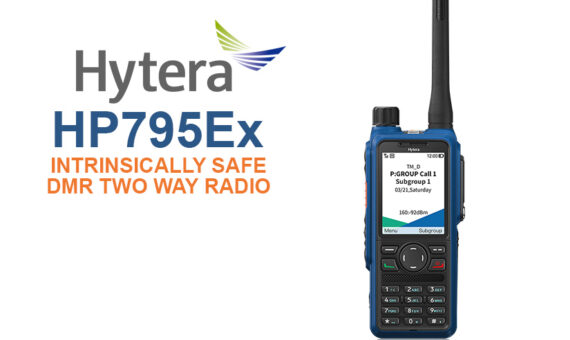Two-way radios are an indispensable tool for many manufacturing operations. By simplifying the communication processes within the workplace, they offer a whole range of benefits that other communication methods can’t compete with.
One critical area where they have a huge part to play is safety within the workplace. Reliable two-way radio communication is an essential tool in keeping employees safe in the manufacturing environment.
The role of two-way radios in safety and crisis management
While two-way radios offer a whole range of benefits in the manufacturing environment, they really come into their own in safety-critical and crisis management situations.
Increased safety with two-way radios
The manufacturing environment can be a dangerous place. Heavy machinery operating around the clock, with workers operating 24 hr shift patterns, always leaves the potential for accidents to occur. Two-way radios should be an indispensable tool anywhere that worker safety is a consideration.
In many safety-critical situations, clear, reliable communication is an essential factor. All it takes is a misunderstanding or a delay in warning of an upcoming hazardous situation, and accidents can occur.
Crystal clear communication is vital in situations where instructions over a distance are necessary to keep workers safe. Two-way radios provide a quality of audio that can still be heard clearly in the often-noisy environments associated with factory floors.
Shouted warnings or instructions are often lost in the background noise of machinery and the general hustle and bustle of a manufacturing plant. High-quality two-way radios provide the perfect safety net to ensure that crucial communication continues uninterrupted despite all the noise.
There is also a range of walkie talkie accessories available to further enhance the quality of audio. These are particularly useful in situations of elevated noise and where communication is critical. In these situations, accessories like hands-free kits, headphones, and other emergency features can be the difference between the safe completion of a task and a serious accident.
Two-way radios in crisis situations
Another safety aspect that two-ways radios offer is designed for lone workers. Many handsets have automated monitoring functions that are essential where lone workers are working amongst potential hazards or in remote locations.
In these situations, a cellular device doesn’t offer the immediacy or automatic safety features that are required to ensure employee safety. Two-way radio systems have features built-in that are designed specifically to enhance a user’s safety in these instances.
● Man Down Function
This incorporates sensors and other automatic systems that activate in certain circumstances. The tilt sensor activates if the user’s body position changes dramatically or the radio suddenly tilts horizontally, both instances being indicative of the user having potentially fallen.
When the handset detects such an event, a timer is activated, which will sound an audio warning to alert the user that the alarm has been triggered. If the alarm has been accidentally triggered, the user can merely disable it. If this is done within a few seconds, then no emergency signal is broadcast.
However, if the user doesn’t respond within a minute, an alarm is broadcast to the other handsets to alert them to the fact that the user is unresponsive.
● Lone Worker Feature
This feature relies on a user interacting with the radio at least once within a pre-ordained period. For example, setting the time period for 15-minutes means that at least once during this time, the user must press a button or adjust a dial on the radio to avoid an automated alarm being activated.
If the user fails to do so, then the handset will initially sound an alarm to prompt the user to take action. If they still don’t interact with the radio at this point, then an emergency notification is broadcast to the other handsets.
● Emergency Alert Button
This is a simple feature, yet it is one of the most highly effective safety functions that two-way radios offer. The Emergency Alert Button is usually prominently positioned at the top of the handset to allow quick and easy access.
If the user is in a dangerous situation, then simply pressing the button once will broadcast an emergency signal to all the other handsets. This signal can either be an audible alarm or a pre-programmed audio message.
The signal identifies the individual in trouble and can drastically reduce the response times in emergency situations.
● GPS Positioning
All the above features can be enhanced if the two-way radios have GPS positioning incorporated into them. The vital minutes and seconds saved locating a colleague in distress can be critical when minimising the effects of an emergency.
Other benefits of two-way radios in the manufacturing sector
There is no doubt that safety in the workplace is of paramount importance. But as well as being essential safety devices, two-way radios also bring a host of other benefits to the table.
● Increased Efficiency
In any field of business, time is money, and the manufacturing sector is one sector where this is certainly the case. Studies have shown that the time saved and the efficiencies created by utilising two-way radios means the handsets pay for themselves in a matter of months.
Good communication across different fields of operation within a facility is often all that it takes to stop a slight hiccup from becoming a production halting problem.
● Productivity Improvements
Manufacturers operate in a tough business environment where profit margins are small, and deadlines are tight. Increasing productivity without increasing costs is the holy grail for many production plant operators.
Two-way radios offer just that. Instant and virtually free communication on a plant-wide basis means that production problems can be identified and addressed as soon as they occur.
A recent survey was undertaken in the manufacturing sector. The results found that 46% of production workers said that two-way radios had reduced downtime by up to 20%.
Conclusion
A high-quality and robust set of two-way radios is a cost-effective method of improving safety in the workplace. Health and Safety regulations put the onus on the employer to ensure their employees are working in as safe an environment as possible.
Two-way radios are among the most cost-effective ways to enhance safety in a multitude of manufacturing environments. And the benefits don’t stop with safety. Production efficiencies and reduced manufacturing costs mean that these devices will soon pay for themselves.







